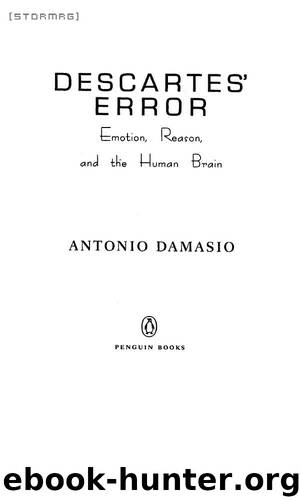Descartes' Error: Emotion, Reason, and the Human Brain by Antonio Damasio

Author:Antonio Damasio [Damasio, Antonio]
Language: eng
Format: mobi, epub
ISBN: 9781101640135
Publisher: Penguin Group US
Published: 2005-09-27T00:00:00+00:00
Figure 7-5. To feel an emotion it is necessary but not sufficient that neural signals from viscera, from muscles and joints, and from neurotransmitter nuclei—all of which are activated during the process of emotion—reach certain subcortical nuclei and the cerebral cortex. Endocrine and other chemical signals also reach the central nervous system via the bloodstream among other routes.
At this point I must make two qualifications. The first concerns the notion of “juxtaposition” in the definition above. I chose this term because I think the image of the body proper appears after the image of the “something else” has been formed and held active, and because the two images remain separate, neurally, as I suggested in the section on images in chapter 5. In other words, there is a “combination” rather than a “blending.” It might be appropriate to use the term superposition for what seems to happen to the images of body proper and “something else” in our integrated experience.
The idea that the “qualified” (a face) and the “qualifier” (the juxtaposed body state) are combined but not blended helps explain why it is possible to feel depressed even as one thinks about people or situations that in no way signify sadness or loss, or feel cheerful for no immediately explainable reason. The qualifier states may be unexpected and sometimes unwelcome. Their psychological motivation may be unapparent or nonexistent, the process arising in a psychologically neutral physiological change. Neurobiologically speaking, the unexplainable qualifiers affirm the relative autonomy of the neural machinery behind the emotions. But they also remind us of the existence of a vast domain of nonconscious processes, some part of which is amenable to psychological explanation and some part of which is not.
The essence of sadness or happiness is the combined perception of certain body states with whatever thoughts they are juxtaposed to, complemented by a modification in the style and efficiency of the thought process. In general, because both the signal of the body state (positive or negative) and the style and efficiency of cognition were triggered from the same system, they tend to be concordant. (Although the concordances between body-state signal and cognitive style can be broken down in normal as well as in pathologic states.) Along with negative body states, the generation of images is slow, their diversity small, and reasoning inefficient; along with positive body states the generation of images is rapid, their diversity wide, and reasoning may be fast though not necessarily efficient. When negative body states recur frequently, or when there is a sustained negative body state, as happens in a depression, the proportion of thoughts which are likely to be associated with negative situations does increase, and the style and efficiency of reasoning suffer. The sustained elation of manic states produces the opposite result. In Darkness Visible, the memoir of his own depression, William Styron has provided definitive descriptions of such a condition. He writes about its essence as a tormenting sense of pain “… most closely connected to drowning or suffocation—but even these images are off the mark.
Download
Descartes' Error: Emotion, Reason, and the Human Brain by Antonio Damasio.epub
This site does not store any files on its server. We only index and link to content provided by other sites. Please contact the content providers to delete copyright contents if any and email us, we'll remove relevant links or contents immediately.
Should I Stay or Should I Go? by Ramani Durvasula(7400)
Why We Sleep: Unlocking the Power of Sleep and Dreams by Matthew Walker(6323)
Flow by Mihaly Csikszentmihalyi(4476)
Fear by Osho(4471)
Why We Sleep by Matthew Walker(4183)
Rising Strong by Brene Brown(4182)
How to Change Your Mind by Michael Pollan(4105)
Too Much and Not the Mood by Durga Chew-Bose(4079)
The Hacking of the American Mind by Robert H. Lustig(4066)
Lost Connections by Johann Hari(3883)
He's Just Not That Into You by Greg Behrendt & Liz Tuccillo(3695)
Evolve Your Brain by Joe Dispenza(3480)
The Courage to Be Disliked by Ichiro Kishimi & Fumitake Koga(3231)
Crazy Is My Superpower by A.J. Mendez Brooks(3192)
What If This Were Enough? by Heather Havrilesky(3184)
Resisting Happiness by Matthew Kelly(3183)
Descartes' Error by Antonio Damasio(3152)
The Book of Human Emotions by Tiffany Watt Smith(3125)
In Cold Blood by Truman Capote(3124)
